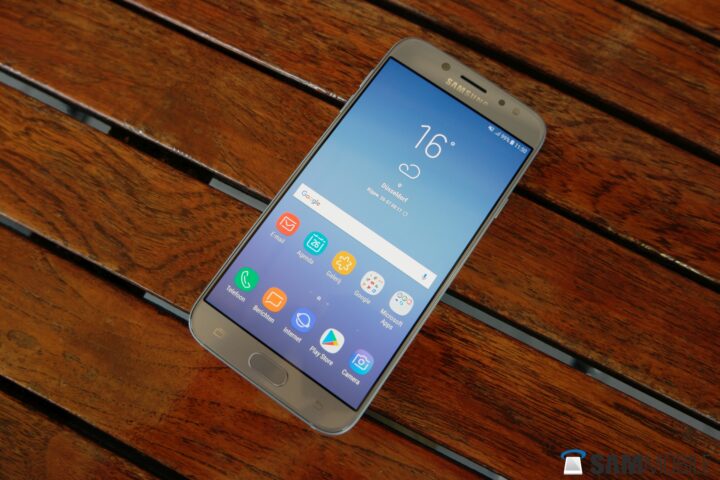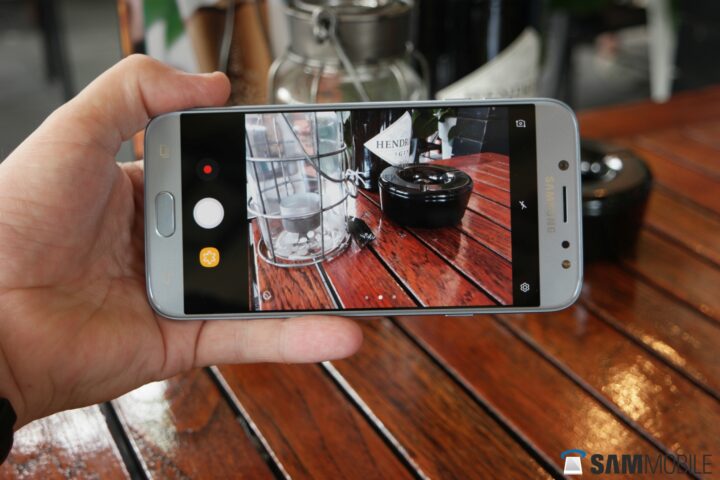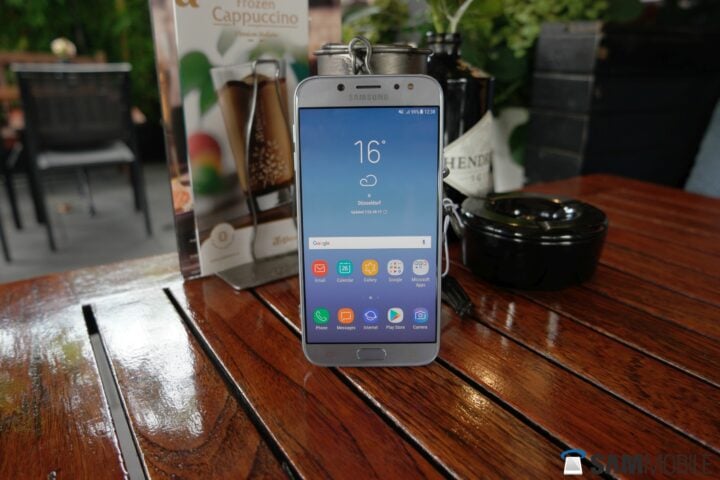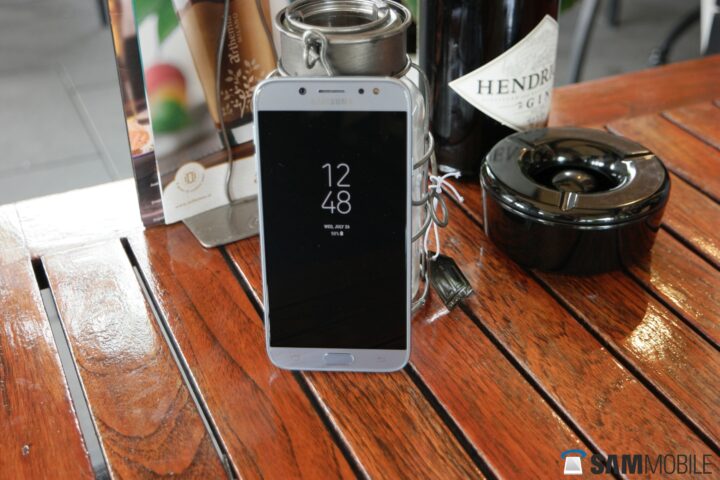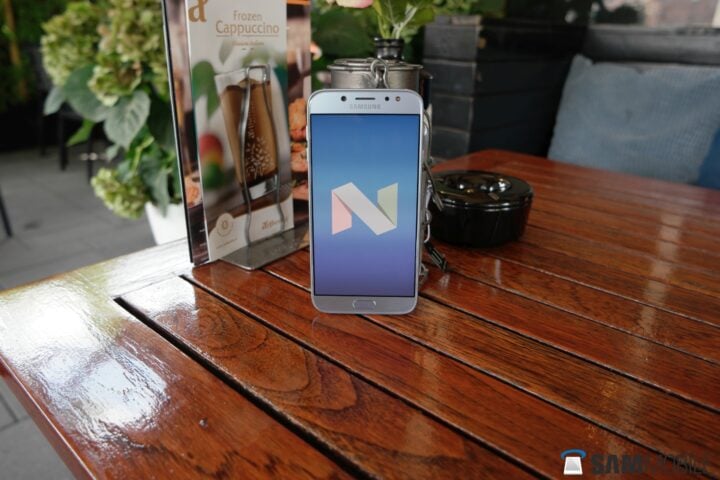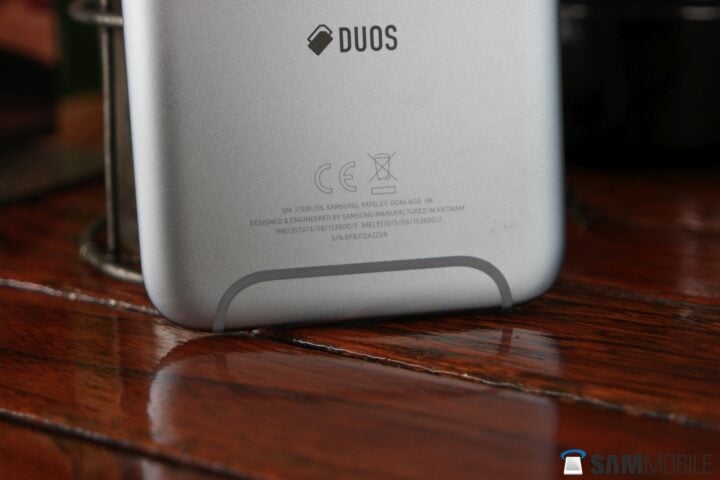Samsung Galaxy J7 (2017) review: A beautiful phone with substandard performance
The first-generation Galaxy J7 was released in June 2015, and now, two years later, we get to test the 2017 variant of the entry-level device. The Galaxy J7 (2017) features a premium metal build, just like the Galaxy J5 (2017) we recently reviewed, and pairs it with a big Super AMOLED display.
Last year, we called the battery on the J7 (2016) ‘’mind-bogglingly impressive.’ This year’s J7 has an even bigger battery, with a 3,600mAh capacity. Another improvement over the last iteration is the addition of a fingerprint scanner in the home button, and of course a full metal body. In this review, you’ll find out if the J7 (2017) is worth your hard-earned money.
Galaxy J7 (2017) review: Design
The moment you pick up the J7 (2017), you notice how premium it feels. The back has a metal unibody design with symmetrical antenna lines along the top and bottom. Because this device is made of metal, it doesn’t look greasy like a phone made of glass. I feel the J7 (2017) is one of the most well-built entry-level phones on the market.
Because the bezels around the 5.5-inch Full HD screen are quite thin, this phone is very easy to hold. No, this device doesn’t come with a fancy Infinity display. But this isn’t necessary because the J7 (2017) feels great the way it is, especially for its price.
There are a few more details you need to know about this design. First of all, you can’t remove the back, meaning the battery isn’t user replaceable. The volume rockers are also of high quality, with good tactile feedback. A microSD slot is included as well, which is a necessity when you have just 16GB of storage out of the box.
Display
The Galaxy J7 (2017) has a 5.5 inch Super AMOLED screen, with a resolution of 1920×1080 pixels. This means you have a pixel density of 401 pixels per inch, resulting in a screen that’s sharp enough for the average user. Of course, Samsung’s PenTile subpixel layout means that this screen does not look as sharp as some other Full HD displays, but I stick with my conclusion that this screen is sharp enough for most.
The colors look very vivid, just like on most of Samsung’s displays. The Super AMOLED display gives this phone an infinite contrast, and overall, you get a great panel on this phone. The infinite contrast enables features like Always On Display (more about that in the software section of this review). The viewing angles are also quite good, and this screen is readable in direct sunlight. The screen is definitely a reason to buy the J7 (2017).
Camera
The camera is the first section of this review where I feel the need to criticise the J7. The 2017 variant of the J7 carries the same sensors as its little brother – the J5. Unfortunately, this isn’t a good thing. In the last few years, phone cameras have become really good. I just don’t feel like the cameras in the J7 are following this trend.
In good lighting conditions, you can take some decent pictures with the 13-megapixel rear camera. But with bright sunlight, the highlights are easily blown, and detail is missed in the dark spots. Overall, the dynamic range of this camera isn’t that good, and the HDR mode is too slow.
Because this sensor is lacking OIS (optical image stabilization), the HDR mode is almost unusable. HDR essentially makes several pictures with a different exposure and combines them into one image with enhanced dynamic range (hence the name High Dynamic Range). Because HDR is slow, and this camera has no OIS, photos with HDR look blurry.
Colours sometimes turn out oversaturated, but most of the time they look a bit dull. But this camera isn’t all bad. The autofocus is plenty fast, making this camera good for point-and-shoot photographers. Thanks to the bigger f/1.7 aperture, low-light photos turn out quite good, especially for a low-end device like the J7.
The front camera has the same resolution as the camera on the back: 13 megapixels. It also has an LED flash, just like the rear camera. The result is pretty good, even if the selfies lack detail for a 13 MP sensor. Photos with the LED flash look good and balanced. The flash itself isn’t as blinding as I expected it to be. Selfies have some noise, but that is to be expected of a small sensor.
With the Galaxy J7, you can shoot videos in Full HD. Due to the digital stabilization, videos don’t look that shaky. Having said that, the lack of OIS is still noticeable. In dark situations, videos look quite shaky, even with the presence of digital stabilization.
All in all, I think that the rear camera isn’t the strong point of the Galaxy J7 (2017). The rear camera is mediocre at best. This means that the camera is good enough for some family and social media pictures. The front camera, however, is plenty good for this price range.
Software
The Galaxy J7 (2017) comes with Android Nougat out of the box. To make the matter even better, the same version of Experience UX as on the Galaxy S8 is also installed – this being version 8.1. This results in the phone having cool features like a theme store for changing the look of your software. Other features like Secure Folder, Samsung Pass, and a Blue light Filter for nighttime usage also come in handy.
One of the best features Samsung included in this iteration is Always On Display (AOD). This means your phone displays a clock and your recent messages when you put your phone on a table. Because of the Super AMOLED display, using AOD just takes a couple of percent of your battery life.
During my testing period, I did not notice any bugs in the software. Because the J7 (2017) will (probably) receive at least one major update, I feel like Samsung did a good job with this phone. Gone are the days of bad software on cheap Samsung phones, or at least the days where there was a huge feature disparity compared to the company’s flagships.
Performance
Under the hood is an octa-core Exynos 7870 processor combined with 3GB of RAM. In short, this processor is not powerful enough. There’s a reason why the 7870 chipset is used in phones with a 720p screen; the Full HD screen in the J7 is just a bit too much. When playing games, the framerate drops very quickly.
Thanks to the 3GB of RAM, browsing with several tabs open is smooth. The same can be said about switching between recently used applications. During daily use, the phone feels just a bit too slow, and under a heavy workload, like updating applications, performance is sluggish. If you care for smooth and fast performance, you’ll probably get annoyed by the J7 (2017).
Audio quality
Unconventionally, some of Samsung’s new phones have a speaker located on the side. Samsung’s philosophy is that this makes the speaker harder to block with your finger. The sound quality produced by this phone is quite balanced, but it lacks in the low frequencies. This is to be expected because producing bass requires a bigger speaker, or dual speakers that Samsung isn’t yet offering in this segment.
The included earbuds sound cheap. I suggest you save some money to buy a good pair of headphones for listening to music. I don’t expect Samsung to include the same headphones they provide with the Galaxy S8, but I do hope the company will up its headphone game for budget smartphones.
Battery life
One of the main reasons to buy the Galaxy J7 (2017) is the battery life. The combination of the modest hardware and the big 3,600 mAh battery results in two days of battery life, and power users should be able to use the phone for a full day. I feel like the irreplaceable battery isn’t a problem because this phone’s battery has such great endurance.
On the bottom of this device is a microUSB port to charge this device. I would have liked it if Samsung had implemented the newer USB Type-C standard, but the microUSB port has the benefit of existing for a longer time, meaning that there are more accessories for your device. The J7 doesn’t support fast charging, but this isn’t to be expected in this price range and is, frankly, not needed with the kind of endurance you’re getting.
Fingerprint reader, other features
The final segment of this review will be about the fingerprint scanner and other notable features. This year is the first time Samsung implemented fingerprint scanners in the J series (not counting the Galaxy J7 Prime that was sold in a few Asian markets). The scanner is located in the home button and can be used to unlock the device, open Secure Folder, and login to websites in Samsung’s browser.
The fingerprint scanner is always on, so you don’t need to push the home button to have your phone unlocked. In my experience, this fingerprint scanner is fast and reliable, so unlocking your phone takes a fraction of a second.
A thing some Android fans will miss is a notification LED. However, I think AOD is excellent for checking your notifications, and coupled with the impressive battery life, itshould negate the need for a notification LED for most users. For people who don’t have that much mobile data, FM radio is included. Of course, you need to plug in your headphones to serve as an antenna.
Conclusion
The new Galaxy J7 has excellent battery life, good design, and a pretty Super AMOLED display. The performance isn’t good enough, though, and the rear camera also slightly underperforms, making this device unsuitable for those who take a lot of pictures and expect high image quality. Features like the fingerprint scanner, expandable storage, and the latest Samsung software make the J7 a good deal for those who don’t play games or perform intensive tasks regularly.
All in all, I think Samsung did a great job with this year’s J7. I really want Samsung’s top-of-the-line devices to have the awesome battery life as this device and other budget Galaxy phones. If you appreciate good build quality, a beautiful screen, and battery life flagships can only dream of, the Galaxy J7 (2017) is the phone for you.
| Pros | Cons |
| Premium metal build | No USB Type-C port |
| Beautiful AMOLED display | No notification LED |
| Excellent battery life | Substandard software performance |
| Fast fingerprint reader | Rear camera could be better |
| Always On Display | |
| Good selfie camera |

